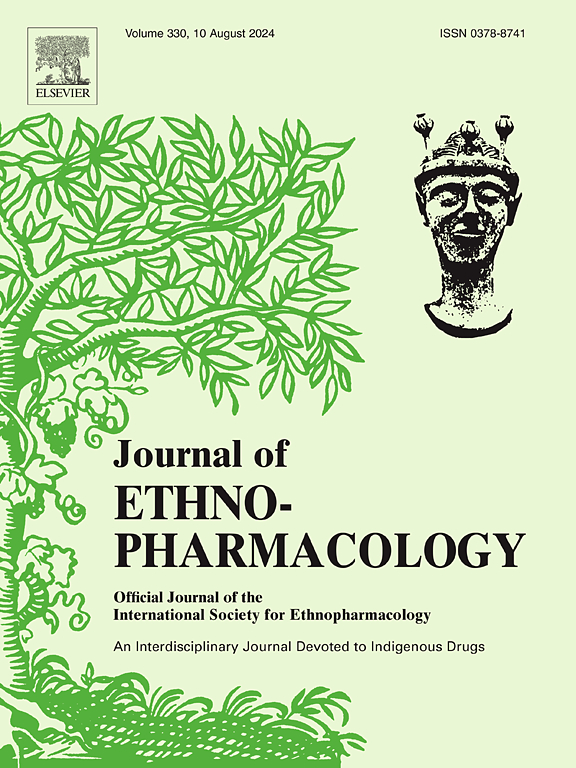从禾草芥中提取的TaraxasterolTzvel。通过调节JAK/STAT和TNF信号通路减轻D-GalN/ lps诱导的暴发性肝炎。
IF 4.8
2区 医学
Q1 CHEMISTRY, MEDICINAL
引用次数: 0
摘要
民族药理学相关性:Taraxasterol (TAR)是藏药Ixeridium gramineum (Fisch.)中含量丰富且易于提取的化合物。Tzvel。显示出多种生物效应,包括肝保护、抗炎和抗氧化活性。研究目的:探讨TAR通过调控JAK/STAT和TNF信号通路,调控氧化应激、炎症反应和细胞凋亡,在暴发性肝炎(FH)中的保护作用及其机制。材料与方法:采用昆明小鼠建立D-GalN/LPS致FH模型,分为对照组、D-GalN/LPS组、D-GalN/LPS +水飞蓟素组、D-GalN/LPS + TAR 2.5组、D-GalN/LPS + TAR 5组、D-GalN/LPS + TAR 10组、TAR 10组。采用H&E染色及生化分析评价肝脏病理变化。ELISA法检测氧化应激因子和炎症反应。通过RNA测序分析,检测TAR干预后肝组织中炎症因子基因和凋亡基因的变化。免疫组化染色法测定p-STAT3和p-JNK蛋白在肝组织中的分布。体外实验采用LPS和TAR处理RAW264.7细胞。流式细胞术及Hoechst 33258染色检测细胞凋亡情况。采用免疫荧光染色法检测RAW264.7细胞中p-STAT3和p-JNK的蛋白表达水平。使用qRT-PCR和Western blotting分析JAK/STAT和TNF信号通路中的基因和蛋白表达以及细胞凋亡。结果:TAR有效减轻肝细胞坏死,减少炎症因子释放,抑制氧化应激,显著降低RAW264.7细胞凋亡,抑制p-JAK2、p-STAT3、p-MEK4、p-JNK、Caspase-3、Caspase-8、Bax蛋白表达,增加SOCS3、Bcl-2蛋白表达。结论:TAR通过调节JAK/STAT和TNF信号通路及细胞凋亡,抑制D-GalN/ lps诱导的FH,显示其治疗肝脏疾病的潜力。本文章由计算机程序翻译,如有差异,请以英文原文为准。

Taraxasterol extracted from Ixeridium gramineum (Fisch.) Tzvel. Attenuated D-GalN/LPS-induced fulminant hepatitis by modulating the JAK/STAT and TNF signalling pathways
Ethnopharmacological relevance
Taraxasterol (TAR), a compound highly abundant and easily obtainable from Tibetan medicine Ixeridium gramineum (Fisch.) Tzvel., exhibits a variety of biological effects, including hepatoprotective, anti-inflammatory, and antioxidant activities.
Aim of the study
To investigated the protective role and underlying mechanisms of TAR in fulminant hepatitis (FH) through the regulation of oxidative stress, inflammatory responses, and apoptosis by modulating the JAK/STAT and TNF signalling pathways.
Material and methods
The study used Kunming mice to establish a D-GalN/LPS-induced FH model, which was divided into the following groups: Control group, D-GalN/LPS group, D-GalN/LPS + Silymarin group, D-GalN/LPS + TAR 2.5 group, D-GalN/LPS + TAR 5 group, D-GalN/LPS + TAR 10 group, and TAR 10 group. H&E staining and biochemical analyses were employed to evaluate liver pathological changes. Oxidative stress factors and inflammatory response were assessed via ELISA. RNA sequencing analysis was used to detect changes in inflammatory factor genes and apoptosis genes with TAR intervention in liver tissues. The distribution of the proteins p-STAT3 and p-JNK in liver tissues was ascertained using immunohistochemical staining. In vitro experiments were conducted on RAW264.7 cells exposed to LPS and TAR. Apoptosis was evaluated via flow cytometry and Hoechst 33258 staining. Immunofluorescence staining was employed to determine the protein expression levels of p-STAT3 and p-JNK in RAW264.7 cells. Gene and protein expression in the JAK/STAT and TNF signalling pathways, as well as apoptosis, were analyzed using qRT-PCR and Western blotting.
Results
TAR effectively reduced hepatocyte necrosis, diminished inflammatory factor release, inhibited oxidative stress, significantly decreased the apoptosis of RAW264.7 cells, inhibited the protein expressions of p-JAK2, p-STAT3, p-MEK4, p-JNK, Caspase-3, Caspase-8, and Bax, and increased the protein expressions of SOCS3 and Bcl-2.
Conclusion
TAR prevents D-GalN/LPS-induced FH by regulating the JAK/STAT and TNF signalling pathways and apoptosis, demonstrating its therapeutic potential in treating liver diseases.
求助全文
通过发布文献求助,成功后即可免费获取论文全文。
去求助
来源期刊

Journal of ethnopharmacology
医学-全科医学与补充医学
CiteScore
10.30
自引率
5.60%
发文量
967
审稿时长
77 days
期刊介绍:
The Journal of Ethnopharmacology is dedicated to the exchange of information and understandings about people''s use of plants, fungi, animals, microorganisms and minerals and their biological and pharmacological effects based on the principles established through international conventions. Early people confronted with illness and disease, discovered a wealth of useful therapeutic agents in the plant and animal kingdoms. The empirical knowledge of these medicinal substances and their toxic potential was passed on by oral tradition and sometimes recorded in herbals and other texts on materia medica. Many valuable drugs of today (e.g., atropine, ephedrine, tubocurarine, digoxin, reserpine) came into use through the study of indigenous remedies. Chemists continue to use plant-derived drugs (e.g., morphine, taxol, physostigmine, quinidine, emetine) as prototypes in their attempts to develop more effective and less toxic medicinals.
 求助内容:
求助内容: 应助结果提醒方式:
应助结果提醒方式:


